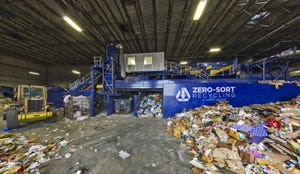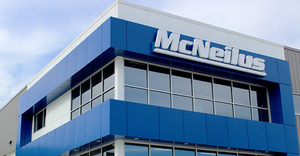Roll with the New
A new approach to fleet maintenance has helped position the Waste-Away Group for future growth.

There's a well-worn cliché used to describe a company's attempt to formulate and adopt new strategies and tactics: “Thinking outside the box.” However, Kenneth Himes will tell you that there's an important — and often unspoken — corollary to that overused phrase: “It helps to know that you're in a box in the first place.”
Like many veterans of the refuse business, Himes, chief operating officer of Elkhart, Ind.-based Waste-Away Group Cos., understood that vehicle maintenance formed the bedrock foundation upon which his family's business rested. Without good maintenance, trucks would break down more often and for longer stretches of time, resulting in poor customer service and higher costs.
Successful vehicle maintenance helped Himes' family, in trucking since the 1940s and in the refuse business since the 1960s, successfully compete against larger competitors such as Waste Management, Republic Services and Allied Waste in local markets for decades. But rapid changes in refuse truck technology made Himes reassess current maintenance operations to see where improvements could be made.
“We do a lot of things well. It's how we've managed to hold our own against the larger national waste companies,” Himes explains. “But as things change around us — the technology, the demands on equipment and personnel — that it put us in a quandary: Could we continue to do the same things over and over and expect the same results or do we want better results?”
Changing the Equipment
In the late 1990s, Waste-Away began shifting to fully automated side-loading trucks for its residential routes, which are serviced by its Borden division. The trucks are not only faster and more efficient — they each typically service 1,200 homes a day with just one driver at the helm, compared to the 300 to 400 homes a day that were serviced by a rear loader with a crew of three — they are safer, too, eliminating lifting injuries and keeping the operator out of traffic.
But automated trucks rely more heavily on hydraulic systems, electronic controls and other moving parts and, as a result, are 25 percent to 30 percent more maintenance intensive than the company's older trucks. “We're always looking to take things to the next level in our business,” Himes says. “But we also don't presume we're doing everything right, either. Our goal is simply to become more efficient and thus more competitive.”
One thing Ken and his brother Charlie Himes, vice president of maintenance at Waste-Away, didn't believe in was the old saw that you either performed all maintenance in-house or outsourced it all to a third party, such as a dealership. In their view, staying as “hands on” as possible when it came to vehicle maintenance (they perform 90 percent of their maintenance in-house) would allow them to better manage downtime. However, the Himes also realized that outside experience and knowledge could help them retool their shop to better handle current economic pressures and equipment needs.
Changing the Shop
Three years ago, Waste-Away brought in Darry Stuart, president of Wrentham, Mass.-based DWS Fleet Management Services to help guide its maintenance restructuring effort. Stuart, who spent five years of his 35-year career as a fleet manager at refuse firm BFI, specializes at being what's termed a “limited time executive.” He reassesses and improves maintenance strategy alongside a fleet's existing personnel, from how the shop is organized down to what parts are stored on the shelf.
“The key for us was to reorganize our maintenance structure so we could maximize the uptime of all our vehicles, even the more maintenance-intensive automated trucks, without falling behind the eight-ball in terms of adding extra cost or downtime for repairs,” Charlie Himes says.
From Stuart's perspective, the biggest maintenance issue facing refuse fleets today is that all the critical focal points are shifting. In the past, oil and grease were the main worries. Today, however, batteries and electrical components are a much higher priority.
“The biggest ‘problem,’ if you will, is the growing sophistication of refuse trucks,” Stuart says. “Take automated trucks: you've got robotic arms powered by extra hydraulic and electronic systems controlled by a driver using a joystick from within the cab. That puts a much higher priority on electrical system components, the truck's batteries, solenoids, etc. — stuff that used to be far down the list of worries on the trucks of the past.”
As a result, maintenance priorities and spending must shift dramatically in order to account for these changes. “You will spend money on maintenance. That's a given,” Stuart says. “The focus for the refuse fleet manager is where — and where not — to spend that maintenance money.”
Though key maintenance strategies remain largely the same for almost all commercial trucks, they are adjusted depending on the particular application. “Using a truck to haul trash is really no different than using a truck to haul freight or whatever, as all trucks have batteries, tires, engines, and other components that need to be maintained,” Stuart explains. “It's just that the use dictates what components you look at first and how often.”
Reorganizing Specs, Shop Practices
One of the first things Stuart did at Waste-Away was create a team of drivers, maintenance technicians and representatives from the hauler's truck and body OEMs (in this case predominantly Mack and Labrie) to go over every inch of the vehicles to determine which parts, should they fail, would put a truck out of service. “It could be something as small as a fan-belt tensioner, or as large as a cylinder or hydraulic steel tube,” he says. “Whatever that part is, no matter the cost, if it puts a truck out of service, you need to have it on your shelf or on the dealer's shelf so you can better manage vehicle uptime.”
Many fleets are worried about tying up dollars in inventory that just sits on a shelf, but Stuart believes refuse fleets in particular need to spend the money to keep at least critical, hard-to-find parts close at hand. “Sure, there's a fear of spending money on parts, but waiting on a part puts a truck down, meaning it's not generating revenue,” he says. “In this case, you are letting someone else manage your uptime if you let someone else manage all your parts inventory.”
Fleets also need to know where those critical components are. “It's no good tracking your parts inventory via computer if your techs can't find it in the stockroom,” Stuart says. “Make sure the parts are easy to find so you can get your trucks fixed and back on the road.”
Next came the addition of a fourth battery to each of the trucks, not exactly an inexpensive proposition for a fleet with just under 100 trucks in its ranks. “There's a direct correlation between the specs you choose to keeping that truck on the street. You can't skimp on [your specs] if you expect to see a return on your investment, and that return is uptime,” Stuart says. “As today's refuse trucks are more electronic-intensive, you need that extra battery power to keep it working, especially in terms of getting trucks to start in the winter.”
The benefit of that spec'ing change came in the second winter of Stuart's work with Waste-Away, when the technician on duty at 5 a.m. didn't have to crawl under half a dozen or more vehicles to get them jump started on an invariably frigid Indiana morning. “That's both reduced work for your maintenance team and reduced downtime for your vehicles,” Stuart says. “That's where more money spent up front saves you money over time.”
It's still important not to give short shrift to the basic maintenance needs of a refuse truck, such as changing the oil, greasing the chassis, maintaining tire pressure, etc. However, it's also critical not to overdo these things — mistakes fleets commonly make.
“The basic iron will last, no problem. Just focusing on the basics consistently will save you money over the life cycle of the vehicles,” Stuart says. Take tires, for example. One refuse fleet that Stuart worked with reduced tire costs by 25 percent in one year simply by focusing on good maintenance practices — maintaining proper tire pressure, inspecting for damage, rotating, balancing and aligning. Brake costs, brake adjustments for them are also way down because we have enhanced the brake repair procedure.”
It also boils down to making sure there's a ready supply of the “simple things” on the part room's shelves ready to go when needed, according to Charlie Himes. “Take hydraulic hoses, steel tubes — we keep a lot of them on our shelves to eliminate vehicle downtime if we have a hose fail,” he says. “It's definitely a delicate balance — what parts to keep on hand in quantity and what parts to make sure our dealer stocks for us. Because time is money: if a repair costs us too much time, more than likely it is costing us too much money.”
In the end, entering into the third year of Waste-Away's maintenance retooling, the company has been able to cut maintenance costs by 20 percent and improve service on the street without adding staff or increasing vehicle downtime for service and repair work. “We do almost entirely preventive maintenance, not demand maintenance resulting from vehicle breakdowns,” says Charlie Himes. “Our route breakdown costs are 1/3 of three years ago.”
Cost savings come not just from reduced dollars spent on maintenance, but from better time management. Less unexpected vehicle downtime — such as jump starts in the morning — translates into fewer instances in which a technician has to be paid overtime to fix a truck or in which a customer has to be given a discount to make up for a missed service date. Better parts management means less time is spent on rush orders for parts while trucks sit idle in a shop bay. “Their uptime on trucks is 99 percent or better, and they have more control over scheduling maintenance around the needs of the operational schedule, not because the truck is down,” Stuart says. “They've adopted the philosophy that the maintenance department does not maintain trucks — rather, they are a team of experts managing valuable assets.”
And that, Kenneth Himes says, is allowing the company to not only better control maintenance costs but prepare it for future growth. “My intent is to position our family's company for the next level of growth, refining our standard operating procedures so we can maintain and improve quality while lowering our costs at the same time,” he says.
Sean Kilcarr is the senior editor of Fleet Owner, a sister publication of Waste Age.
Related Stories
Maintenance Basics: The Checklist
Settling up a solid preventive maintenance (PM) program is critical but does not need to be either complicated or expensive, according to Darry Stuart, president of Wrentham, Mass.-based DWS Fleet Management Services. His basic PM checklist only contains 12 items, but those items are critical, he says. Below are a few of the items:
Batteries: If the battery charge is low, the truck may not start. Stuart stresses that battery cables have to be disconnected, cleaned and load-tested at each PM interval to make sure a full charge is getting through. Of particular concern: low-voltage batteries. Though they may get a truck started, a low-voltage battery puts a lot more pressure on the truck's alternator and starter, leading to a shorter life cycle for those components.
Cooling systems: Because of the new federal emission rules, truck engines today generate a lot of heat. So your cooling systems must be in top shape. Furthermore, the high temperatures generated by the engine and other systems can evaporate any traces of coolant leaks, making a repetitive problem that much harder to find. So at every PM interval, regular pressure testing of the cooling system is a must.
Tires: This is probably one of the most expensive areas of truck maintenance. Darry says the key is to keep tires properly inflated and make sure the front axle is aligned properly to minimize abnormal tire wear.
U-bolts/fasteners: Darry is a fanatic about tightening chassis and axle u-bolts and wheel/rim fasteners at every PM interval. “Trucks endure a lot of vibration from all the maneuvering, turning, heavy loading and unloading they do every day,” he says. “Those bolts are holding your truck together so you have to watch them.”
Oil and grease: Darry is a big believer in buying the best engine oil and component grease available, simply because they can help add life to your equipment. “Front ends, clutch linkages and especially u-joints need the best grease you can buy, he says. “Buy quality not price. If you don't grease a u-joint regularly, it's going to blow out on you, and when that happens you have to tow the vehicle in. That's expensive. That's why paying attention to the small details helps you avoid the big problems in the long run.”
For more preventive maintenance tips, go to www.darrystuart.com.
About the Author
You May Also Like


